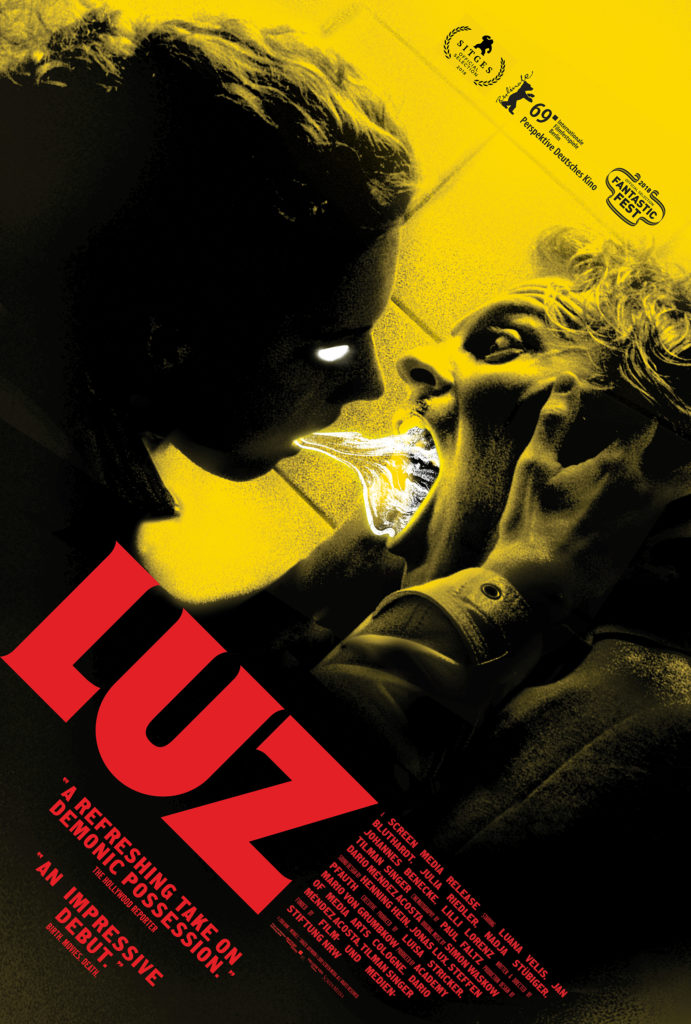When it comes to horror genre evolution, possession films consistently walk the line dividing the mediocre from the innovative. The basic premise remains the same, with an evil force making its way into the body of an unsuspecting victim, and the numerous plot details vary in dramatic range to spin a generally scary narrative. While many serve the masses, every now and then a particularly creative spirit enters the atmosphere and exerts dominant pioneering control. A demon by the name of Tilman Singer indulges himself in the riches of fresh possession horror with his debut feature film and genre novelty, Luz.
If modern arthouse horror met Rene Magritte, their love child would be born in a Lynchian euphoria and be named Luz.
Written and directed by Singer, this hyperactive possession story begins when “Luz, a young cabdriver, drags herself into the brightly lit entrance of a run-down police station. A demonic entity follows her, determined to finally be close to the woman it loves.” It runs within a shocking 70 minutes, but performs a miracle in the way it expands throughout an increasingly odd and chaotic environment. The extraordinary use of sound effects and sublime imagery cultivated by a minimal script places Luz in an elite horror category all its own, one sparsely represented.
Disorienting transitions between the different physical settings of Luz create a beautifully hypnotic movement through the film while drawing the plot into a trance suspended in alternative scapes of the psyche.
The Love Child of Contemporary Craft
Keeping a steady finger on the pulse of long-lasting terror (or at least a taut 70 minutes worth), Luz is equal parts weird love story and progressive possession at its smartest. Dramatic and consistently disturbing imagery set in sharp scenes act their peculiar ways out into the fashion of a contemporary pulp-style play. The observational narrative slowly, but effectively, builds on a lucid mountain of tension while sharply illuminating the phenomenal performances of Luana Velis (Diebe des Schlafes), Jan Bluthardt (Tatort), and Julia Rideler (Goster) in an even coat of pure, raw talent. Singer takes advantage of the story’s electric emotion and familiar content to rework the formula with the addition of bizarre set pieces and unique iteration of demonic possession, submitting Luz to the forces of higher film craftsmanship. If modern arthouse horror met Rene Magritte, their love child would be born in a Lynchian euphoria and be named Luz.
…the illogical sequences, subdued feel, restricted dialogue, and vacant spaces create a prime state of authentic cinematic dread.
The Setting of Singer
Concise in its daunting yet structured unraveling, Luz puts the viewer in places where the scene never actually goes. Its surreal timeline and use of space plays to some of Singer’s greatest strengths. Unapologetically strange and chaotic settings engage viewers as they isolate them in a New Age way. It has a unique method of pulling both the characters and the viewers through the motions and surroundings of a possession based in reality. Disorienting transitions between the different physical settings of Luz create a beautifully hypnotic movement through the film while drawing the plot into a trance suspended in alternative scapes of the psyche. Though a large portion of the film is derived from ongoing exposition and a majority of the fantastic visuals are presented for sheer interpretation, the illogical sequences, subdued feel, restricted dialogue, and vacant spaces create a prime state of authentic cinematic dread.
The extraordinary use of sound effects and sublime imagery cultivated by a minimal script places Luz in an elite horror category all its own, one sparsely represented.
The stage in which Luz covets every viewer’s attention appropriately sets all involved up for praise. The elements, from basic to inspired, are meticulously situated in a slightly hallucinatory vision basking in the air of a cinematic experience. When it comes to breaking it down, the words describing Luz as disorienting, incoherent, and chaotic, may insinuate the film has poor taste, but the surprise is that all these negative adjectives are worked to total perfection. Singer finds a way to take all of the things we hate about other possession films, make them disappear, and replace them with even more jarring factors, but those of enjoyable caliber. Its unconventional constitution as a whole may not be comprehensive to all, or appreciated, but it should be purely respected for the step it took towards progressive horror and away from bland, formulaic possession films.

‘Luz’ Possesses A Novel Stage of Sound, Space, and Cinema [Review]
Präzise































